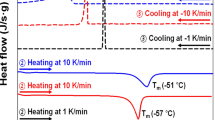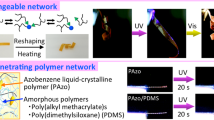Abstract
The self-organization of liquid-crystalline monomers and subsequent polymerization is a unique strategy for creating nanostructured polymer membranes with novel functions and innovative properties. In this study, we developed gyroid nanostructured soft polymer films based on this strategy. Two types of amphiphile zwitterion monomers were designed and synthesized: a single-type amphiphile zwitterion monomer (S-ZI) and a gemini-type monomer (G-ZI). These compounds show liquid-crystalline behavior in the presence of bis(trifluoromethanesulfonyl)imide (HTf2N) and water. We attempted to find an appropriate mixing ratio of S-ZI and G-ZI that satisfied the following two criteria: suitability for the exhibition of bicontinuous cubic (Cubbi) phases and acquisition of self-standing properties and softness. The 25/75 wt% component ratio of S-ZI/G-ZI was found to meet these conditions. By carrying out a polymerization for the mixture in the above mixing ratio in the Cubbi phase, a polymer film with self-standing properties and resistance to bending was successfully obtained. This film showed a high ionic conductivity of 1.27 × 10−2 S cm−1 under a relative humidity of 90%.
This is a preview of subscription content, access via your institution
Access options
Subscribe to this journal
Receive 12 print issues and online access
$259.00 per year
only $21.58 per issue
Buy this article
- Purchase on Springer Link
- Instant access to full article PDF
Prices may be subject to local taxes which are calculated during checkout










Similar content being viewed by others
References
Kreuer KD, Paddison SJ, Spohr E, Schuster M. Transport in proton conductors for fuel-cell applications: simulations, elementary reactions, and phenomenology. Chem Rev 2004;104:4637–78.
Essam JW. Percolation theory. Rep Prog Phys. 1980;43:833–912.
Mariani P, Luzzati V, Delacroix H. Cubic phases of lipid-containing systems. Structure analysis and biological implications. J Mol Biol. 1988;204:165–89.
Ichikawa T, Kato T, Ohno H. 3D Continuous water nanosheet as a gyroid minimal surface formed by bicontinuous cubic liquid-crystalline zwitterions. J Am Chem Soc 2012;134:11354–57.
Kobayashi T, Li Y, Ono A, Zeng X, Ichikawa T. Gyroid structured aqua-sheets with sub-nanometer thickness enabling 3D fast proton relay conduction. Chem Sci 2019;10:6245–53.
Yang D, O’Brien DF, Marder SR. Polymerized bicontinuous cubic nanoparticles (cubosomes) from a reactive monoacylglycerol. J Am Chem Soc 2002;124:13388–89.
Pindzola BA, Jin J, Gin DL. Cross-linked normal hexagonal and bicontinuous cubic assemblies via polymerizable gemini amphiphiles. J Am Chem Soc 2003;125:2940–49.
Jin LY, Bae J, Ryu JH, Lee M. Ordered nanostructures from the self-assembly of reactive coil–rod–coil molecules. Angew Chem Int Ed 2006;45:650–3.
Yoshio M, Kagata T, Hoshino K, Mukai T, Ohno H, Kato T. One-dimensional ion-conductive polymer films: alignment and fixation of ionic channels formed by self-organization of polymerizable columnar liquid crystals. J Am Chem Soc 2006;128:5570–7.
Batra D, Hay DNT, Firestone MA. Formation of a biomimetic, liquid-crystalline hydrogel by self-assembly and polymerization of an ionic liquid. Chem Mater 2007;19:4423–31.
Ichikawa T, Yoshio M, Hamasaki A, Kagimoto J, Ohno H, Kato T. 3D Interconnected ionic nano-channels formed in polymer films: self-organization and polymerization of thermotropic bicontinuous cubic liquid crystals. J Am Chem Soc 2011;133:2163–9.
Takeuchi H, Ichikawa T, Yoshio M, Kato T, Ohno H. Induction of bicontinuous cubic liquid-crystalline assemblies for polymerizable amphiphiles via tailor-made design of ionic liquids. Chem Commun 2016;52:13861–4.
Shimizu Y, Takeuchi H, Takeuchi R, Ichikawa T. Amphotropic liquid-crystalline behaviour of glycolipids in amino acid ionic liquids. Liq Cryst 2019;46:1298–306.
Broer DJ, Bastiaansen CMW, Debije MG, Schenning APHJ. Functional organic materials based on polymerized liquid-crystal monomers: supramolecular hydrogen-bonded systems. Angew Chem Int Ed 2012;51:7102–9.
Beginn U, Zipp G, Möller M. Functional membranes containing ion‐selective matrix‐fixed supramolecular channels. Adv Mater 2000;12:510–3.
Zhang H, Li L, Möller M, Zhu X, Rueda JJH, Rosenthal M, et al. From channel‐forming ionic liquid crystals exhibiting humidity‐induced phase transitions to nanostructured ion‐conducting polymer membranes. Adv Mater 2013;25:3543–8.
Rueda JJH, Zhang H, Rosenthal M, Möller M, Zhu X, Ivanov DA. Polymerizable wedge-shaped ionic liquid crystals for fabrication of ion-conducting membranes: Impact of the counterion on the phase structure and conductivity. Eur Polym J 2016;81:674–85.
Hemmi M, Nakatsuji K, Ichikawa T, Tomioka H, Sakamoto T, Yoshio M, et al. Self-organized liquid-crystalline nanostructured membranes for water treatment: selective permeation of ions. Adv Mater 2012;24:2238–41.
Sakamoto T, Ogawa T, Nada H, Nakatsuji K, Mitani M, Soberats B, et al. Development of nanostructured water treatment membranes based on thermotropic liquid crystals: molecular design of sub‐nanoporous materials. Adv Sci 2018;5:1700405.
Gupta M, Suzuki Y, Sakamoto T, Yoshio M, Torii S, Katayama H, et al. Polymerizable photocleavable columnar liquid crystals for nanoporous water treatment membranes. ACS Macro Lett. 2019;8:1303–8.
Matsumoto A, Fujioka D, Kunisue T. Organic intercalation of unsaturated amines into layered polymer crystals and solid-state photoreactivity of the guest molecules in constrained interlayers. Polym J 2003;35:652–61.
Zhou M, Nemade PR, Lu X, Zeng X, Hatakeyama ES, Noble RD, et al. New type of membrane material for water desalination based on a cross-linked bicontinuous cubic lyotropic liquid crystal assembly. J Am Chem Soc 2007;129:9574–5.
Hatakeyama ES, Wiesenauer BR, Gabriel CJ, Noble RD, Gin DL. Nanoporous, bicontinuous cubic lyotropic liquid crystal networks via polymerizable gemini ammonium surfactants. Chem Mater 2010;22:4525–7.
Sorenson GP, Coppage KL, Mahanthappa MK. Unusually stable aqueous lyotropic gyroid phases from gemini dicarboxylate surfactants. J Am Chem Soc 2011;133:14928–31.
Sorenson GP, Mahanthappa MK. Unexpected role of linker position on ammonium gemini surfactant lyotropic gyroid phase stability. Soft Mater. 2016;12:2408–15.
Matsumoto T, Ono A, Ichikawa T, Kato T, Ohno H. Construction of gyroid-structured matrices through the design of geminized amphiphilic zwitterions and their self-organization. Chem Commun 2016;52:12167–70.
Ono A, Ohno H, Kato T, Ichikawa T. Design of 3D continuous proton conduction pathway by controlling co-organization behavior of gemini amphiphilic zwitterions and acids. Solid State Ion. 2018;317:39–45.
Kusoglu A, Weber AZ. New insights into perfluorinated sulfonic-acid ionomers. Chem Rev 2017;117:987–1104.
Ogawa T, Aonuma T, Tamaki T, Ohashi H, Ushiyama H, Yamashita K, et al. The proton conduction mechanism in a material consisting of packed acids. Chem Sci 2014;5:4878–87.
Kreuer KD. On the development of proton conducting polymer membranes for hydrogen and methanol fuel cells. J Membr Sci 2001;185:29–39.
Hickner MA, Ghassemi H, Kim YS, Einsla BR, McGrath JE. Alternative polymer systems for proton exchange membranes (PEMs). Chem Rev 2004;104:4587–612.
Lafitte B, Jannasch P. Proton‐conducting aromatic polymers carrying hypersulfonated side chains for fuel cell applications. Adv Funct Mater 2007;17:2823–34.
Bae B, Yoda T, Miyatake K, Uchida H, Watanabe M. Proton‐conductive aromatic ionomers containing highly sulfonated blocks for high‐temperature‐operable fuel cells. Angew Chem Int Ed. 2010;49:317–20.
Nimmanpipug P, Kodchakorn K, Lee VS, Yana J, Jarumaneeroj C, Phongtamrug S, et al. Structural and transport phenomena of urocanate‐based proton carrier in sulfonated poly(ether ether ketone) membrane composite. J Polym Sci Part B. 2018;56:1625–35.
Park MJ, Balsara NP. Anisotropic proton conduction in aligned block copolymer electrolyte membranes at equilibrium with humid air. Macromolecules. 2010;43:292–8.
Michau M, Barboiu M. Self-organized proton conductive layers in hybrid proton exchange membranes, exhibiting high ionic conductivity. J Mater Chem 2009;19:6124–31.
Chow CF, Roy VAL, Ye Z, Lam MHW, Lee CS, Lau KC. Novel high proton conductive material from liquid crystalline 4-(octadecyloxy)phenylsulfonic acid. J Mater Chem 2010;20:6245–9.
Chen Y, Thorn M, Christensen S, Versek C, Poe A, Hayward RC, et al. Enhancement of anhydrous proton transport by supramolecular nanochannels in comb polymers. Nat Chem 2010;2:503–8.
Ueda S, Kagimoto J, Ichikawa T, Kato T, Ohno H. Anisotropic proton-conductive materials formed by the self-organization of phosphonium-type zwitterions. Adv Mater 2011;23:3071–4.
Kato T, Yoshio M, Ichikawa T, Soberats B, Ohno H, Funahashi M. Transport of ions and electrons in nanostructured liquid crystals. Nat Rev Mater 2017;2:17001.
Tunkara E, Albayrak C, Polat EO, Kocabas C, Dag Ö. Highly proton conductive phosphoric acid–nonionic surfactant lyotropic liquid crystalline mesophases and application in graphene optical modulators. ACS Nano. 2014;8:11007–12.
Nagao Y. Proton-conductivity enhancement in polymer thin films. Langmuir. 2017;33:12547–58.
Ichikawa T. Zwitterions as building blocks for functional liquid crystals and block copolymers. Polym J 2017;49:413–21.
Kobayashi T, Ichikawa T, Kato T, Ohno H. Development of glassy bicontinuous cubic liquid crystals for solid proton-conductive materials. Adv Mater 2017;29:1604429.
Impéror-Clerc M. Thermotropic cubic mesophases. Curr Opin Colloid Interface Sci 2005;9:370–6.
Diele S. On thermotropic cubic mesophases. Curr Opin Colloid Interface Sci 2002;7:333–42.
Bruce DW. Calamitics, cubics, and columnars liquid-crystalline complexes of silver(I). Acc Chem Res 2000;33:831–40.
Fuchs P, Tschierske C, Raith K, Das K, Diele S, Thermotropic A. Mesophase comprised of closed micellar aggregates of the normal type. Angew Chem Int Ed 2002;41:628–31.
Kutsumizu S. Recent progress in the synthesis and structural clarification of thermotropic cubic phases. Isr J Chem 2012;52:844–53.
Cho BK, Jain A, Gruner SM, Wiesner U. Mesophase structure-mechanical and ionic transport correlations in extended amphiphilic dendrons. Science. 2004;305:1598–601.
Gin DL, Lu X, Nemade PR, Pecinovsky CS, Xu Y, Zhou M. Recent advances in the design of polymerizable lyotropic liquid‐crystal assemblies for heterogeneous catalysis and selective separations. Adv Funct Mater 2006;16:865–78.
Ichikawa T, Yoshio M, Hamasaki A, Mukai T, Ohno H, Kato T. Self-organization of room-temperature ionic liquids exhibiting liquid-crystalline bicontinuous cubic phases: formation of nano-ion channel networks. J Am Chem Soc 2007;129:10662–3.
Ichikawa T, Yoshio M, Taguchi S, Kagimoto J, Ohno H, Kato T. Co-organisation of ionic liquids with amphiphilic diethanolamines: construction of 3D continuous ionic nanochannels through the induction of liquid-crystalline bicontinuous cubic phases. Chem Sci 2012;3:2001–8.
Ichikawa T, Yoshio M, Hamasaki A, Taguchi S, Liu F, Zeng X, et al. Induction of thermotropic bicontinuous cubic phases in liquid-crystalline ammonium and phosphonium salts. J Am Chem Soc 2012;134:2634–43.
Cho BK. Nanostructured organic electrolytes. RSC Adv. 2014;4:395–405.
Goossens K, Lava K, Bielawski CW, Binnemans K. Ionic liquid crystals: versatile materials. Chem Rev 2016;116:4643–807.
Ichikawa T, Kato T, Ohno H. Dimension control of ionic liquids. Chem Commun 2019;55:8205–14.
Uemura N, Kobayashi T, Yoshida S, Li Y, Goossens K, Zeng X, et al. Double gyroid nanostructure formation by aggregation-induced atropisomerization and co-assembly of ionic liquid-crystalline amphiphiles. Angew Chem Int Ed 2020;59:8445–50.
Acknowledgements
TI is grateful for financial support from the Precursory Research for Embryonic Science and Technology (PRESTO) from the Japan Science and Technology Agency (JST) (no. JPMJPR1413). This work was supported by the Japan Society for the Promotion of Science, Grants-in-Aid for Scientific Research (B) (no. 17H03038). This work was supported by the Izumi Science and Technology Foundation (2018-J-081). TK is grateful for financial support from the JSPS Research Fellowships for Young Scientists (no. JP 18J21088).
Author information
Authors and Affiliations
Corresponding author
Ethics declarations
Conflict of interest
The authors declare that they have no conflict of interest.
Additional information
Publisher’s note Springer Nature remains neutral with regard to jurisdictional claims in published maps and institutional affiliations.
Supplementary information
41428_2020_436_MOESM1_ESM.docx
Gyroid nanostructured soft membranes formed by controlling the degree of crosslinking polymerization of bicontinuous cubic liquid-crystalline monomers
Rights and permissions
About this article
Cite this article
Maekawa, A., Kobayashi, T. & Ichikawa, T. Gyroid nanostructured soft membranes formed by controlling the degree of crosslinking polymerization of bicontinuous cubic liquid-crystalline monomers. Polym J 53, 463–470 (2021). https://doi.org/10.1038/s41428-020-00436-0
Received:
Revised:
Accepted:
Published:
Issue Date:
DOI: https://doi.org/10.1038/s41428-020-00436-0



